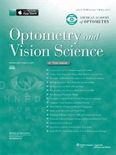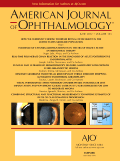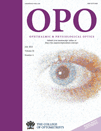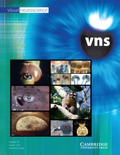
Annual Review of Vision Science
metrics 2024
Bridging Research and Practice in Vision Science
Introduction
The Annual Review of Vision Science is an esteemed journal published by ANNUAL REVIEWS, focused on advancing the field of vision science through comprehensive reviews that synthesize current research and emerging trends. With an ISSN of 2374-4642 and E-ISSN 2374-4650, this journal has established itself as a leading source of high-quality academic content, boasting a prestigious Q1 ranking in the fields of Medicine (miscellaneous), Neurology (clinical), and Ophthalmology as of 2023. Its impressive Scopus rankings further attest to its influence, placing it in the top 5 within ophthalmology (96th percentile) and 31st in clinical neurology (92nd percentile). The journal aims to serve researchers, clinicians, and students alike by providing critical insights into vision science, thereby enhancing understanding and fostering innovation in both basic and applied research. Although not open access, the Annual Review of Vision Science remains a vital resource for those engaged in the study and application of vision science worldwide.
Metrics 2024
 2.49
2.49 5.00
5.00 7.10
7.10 43
43Metrics History
Rank 2024
Scopus
IF (Web Of Science)
JCI (Web Of Science)
Quartile History
Similar Journals

INTERNATIONAL JOURNAL OF COMPUTER VISION
Illuminating the Path of AI and Visual Recognition.INTERNATIONAL JOURNAL OF COMPUTER VISION, published by Springer, is a premier peer-reviewed journal that stands at the forefront of the fields of Computer Vision and Artificial Intelligence. With a remarkable impact factor and rankings placing it in the Q1 category across key areas such as Computer Vision and Pattern Recognition, as well as Software, this journal serves as an essential resource for researchers, professionals, and students alike. Since its inception in 1987, it has aimed to advance the understanding and methodologies within the rapidly evolving landscape of computer vision technologies. Its location in the Netherlands underlines its international significance, and with Scopus rankings placing it in the top percentiles of its categories, the journal is recognized for its contribution to groundbreaking research and innovative applications. Although it is not an open-access journal, it still provides extensive access options through institutional and personal subscriptions, offering its readers in-depth insights and findings pivotal to their work in artificial intelligence and computational technologies.

MOLECULAR VISION
Exploring groundbreaking discoveries in ophthalmology.MOLECULAR VISION is a premier open-access journal that has been advancing the field of ophthalmology since its inception in 1995. Published by MOLECULAR VISION, this journal boasts a strong reputation, currently ranking in the second quartile (Q2) of its category, with a Scopus ranking of 35 out of 137, placing it in the 74th percentile among peer publications. Dedicated to disseminating groundbreaking research and innovative findings in the study of vision and ocular health, MOLECULAR VISION serves as a vital resource for researchers, healthcare professionals, and students engaged in this dynamic field. The journal welcomes contributions spanning fundamental and clinical research, offering a platform for crucial knowledge exchange that is essential for advancing ocular health and function. With its commitment to open access, readers around the globe can freely access and build upon the wealth of information disseminated through its pages, ensuring that the latest developments in ophthalmology are available to all.

CAAI Transactions on Intelligence Technology
Elevating Standards in AI and Computer ScienceCAAI Transactions on Intelligence Technology is a premier peer-reviewed journal published by WILEY, dedicated to advancing the fields of Artificial Intelligence, Computer Networks and Communications, Computer Vision and Pattern Recognition, Human-Computer Interaction, and Information Systems. Since its inception in 2017, this Open Access journal has rapidly ascended the ranks, achieving Q1 quartile status across multiple categories as of 2023, and is recognized for its rigorous standards and innovative research dissemination, evidenced by impressive Scopus rankings, including Rank #12 in Computer Vision and Pattern Recognition. Through its commitment to providing a platform for high-quality research, the journal invites contributions from scholars globally, fostering a collaborative environment that stimulates intellectual exchange and encourages advancements in intelligent technology. Addressed to researchers, professionals, and students alike, CAAI Transactions on Intelligence Technology serves as a vital resource for those aiming to stay at the forefront of technological innovation.

OPTOMETRY AND VISION SCIENCE
Advancing Eye Care Through Scientific ExcellenceOptometry and Vision Science is a premier journal published by Lippincott Williams & Wilkins, dedicated to advancing the field of optometry and ophthalmology. With a rich history dating back to 1905 and a strong emphasis on scientific rigor, the journal has established itself as a vital resource for researchers, professionals, and students alike. Currently ranked in the Q2 category for both Ophthalmology and Optometry, it occupies a significant position in the academic community, as evidenced by its Scopus rankings of #61 among 137 in Medicine - Ophthalmology and #6 among 12 in Health Professions - Optometry. The journal publishes original research, clinical studies, and critical reviews that contribute to the understanding of visual science, the development of innovative practices, and the enhancement of patient care. Although it is not open access, its impactful content is available to subscribers and institutions, fostering a deeper insight into the complexities of vision science. As we approach the journal's centennial milestone in 2024, Optometry and Vision Science continues to reflect the evolving landscape of eye care research and is poised to inspire a new generation of vision scientists.

JOURNAL OF VISION
Illuminating the Frontiers of Vision ScienceThe JOURNAL OF VISION, published by the ASSOCIATION FOR RESEARCH IN VISION AND OPHTHALMOLOGY INC, stands as a premier platform in the fields of Ophthalmology and Sensory Systems. Since its inception in 2001, this Open Access journal has worked to disseminate innovative research and groundbreaking discoveries that advance our understanding of vision science. With an impressive impact factor and ranked in the Q2 quartile for both Ophthalmology and Sensory Systems categories as of 2023, it offers a remarkable avenue for scholars and practitioners alike to share their insights and foster collaboration. Based in the United States, the journal maintains a commitment to accessibility, allowing researchers worldwide to engage with its comprehensive body of work. The JOURNAL OF VISION not only enhances the global dialogue around ocular health and sensory processing but also serves as an essential resource for professionals aiming to stay at the forefront of vision research.

AMERICAN JOURNAL OF OPHTHALMOLOGY
Empowering Knowledge in OphthalmologyAmerican Journal of Ophthalmology, published by Elsevier Science Inc, stands as a premier outlet for significant advancements in the field of ophthalmology. Established in 1918, this journal has a long-standing tradition of disseminating high-quality research, which is reflected in its impressive Scopus ranking, positioned at #8 out of 137 in the ophthalmology category, placing it in the 94th percentile. With its 2023 designation as Q1 in Ophthalmology, it serves as a critical platform for researchers, practitioners, and students who seek to stay at the forefront of ocular health and visual science. Although the journal does not currently offer open access options, it provides an array of access formats, ensuring that valuable research is available to a broad audience dedicated to the exploration and understanding of eye diseases and treatments. As it continues to evolve towards 2024, the American Journal of Ophthalmology remains essential for anyone engaged in ophthalmic research and clinical practice.

Open Ophthalmology Journal
Innovating vision science for a brighter tomorrow.The Open Ophthalmology Journal, published by Bentham Science Publishers Ltd, is a vital resource in the field of ophthalmology, dedicated to advancing knowledge through open-access research. With an ISSN of 1874-3641, it offers a platform for the dissemination of innovative studies from 2011 to 2024, focusing on the latest developments in eye care and vision science. Despite being categorized in the lower quartile (Q4) according to the 2023 rankings, and holding a position in the Scopus Ricks at 113 out of 137 in the ophthalmology domain, the journal serves as a valuable outlet for emerging scholars and seasoned researchers alike to share their findings. The journal's commitment to accessibility ensures that its content is available to a broad audience, promoting collaboration and knowledge exchange. Located in the Netherlands, The Open Ophthalmology Journal aspires to become a cornerstone for those passionate about understanding and improving ocular health through rigorous scientific inquiry.

Journal of Optometry
Championing accessibility in optometric research.The Journal of Optometry, published by Elsevier, is a leading open access journal dedicated to advancing the field of optometry and vision science. With an ISSN of 1888-4296 and an E-ISSN of 1989-1342, this journal serves as a pivotal platform for researchers, practitioners, and academics alike to disseminate and engage with high-quality original research and review articles. As of 2023, the journal holds an impressive Q2 ranking in the Optometry category, demonstrating its influence and relevance, particularly as it ranks #2 out of 12 in the Health Professions - Optometry category on Scopus with an 87th percentile. Since becoming open access in 2008, the Journal of Optometry has prioritized accessibility and the exchange of ideas, enriching the scholarly community and enhancing practical application in clinical settings. The journal welcomes submissions that push the boundaries of ocular research, clinical practices, and the education of optometry professionals, making it an essential resource for anyone invested in the future of eye health.

OPHTHALMIC AND PHYSIOLOGICAL OPTICS
Illuminating the path to understanding visual systems.Ophthalmic and Physiological Optics, published by Wiley, is a premier peer-reviewed journal dedicated to advancing the fields of ophthalmology, optometry, and sensory systems. With an impressive impact factor and categorized in the prestigious Q1 quartile for 2023 across multiple disciplines, the journal provides a vital platform for researchers and practitioners to disseminate innovative findings and explore the complexities of visual science. Founded in 1981, it continues to thrive as a leading resource for reviewing contemporary issues, emerging technologies, and clinical practices. Readers will benefit from its rigorous editorial standards and access to groundbreaking studies pertinent to both academic and clinical environments. Situated at the forefront of the discipline, Ophthalmic and Physiological Optics plays an essential role in bridging the gap between research and practical application, ensuring a comprehensive understanding of vision and its physiological underpinnings.

VISUAL NEUROSCIENCE
Illuminating the Pathways of VisionVISUAL NEUROSCIENCE is a distinguished journal dedicated to advancing the understanding of visual processing through neuroscientific research. Published by Cambridge University Press and indexed in Scopus, this journal emphasizes the latest experimental and theoretical insights into the neurological basis of vision. Since its inception in 1988, VISUAL NEUROSCIENCE has effectively contributed to the field, showcasing high-quality research and innovative findings. Although it currently sits in the Q3 and Q4 quartiles for Physiology and Sensory Systems respectively, its commitment to rigorous research has allowed it to maintain relevance in a diverse array of scientific disciplines. Researchers, professionals, and students alike will find value in its comprehensive articles that explore the complexities of visual perception and associated neural mechanisms. The journal does not offer open access options, enhancing the exclusivity of its researched content. Set against the backdrop of Cambridge, England, VISUAL NEUROSCIENCE stands as an essential platform for the dissemination of knowledge in the vibrant field of visual neuroscience.